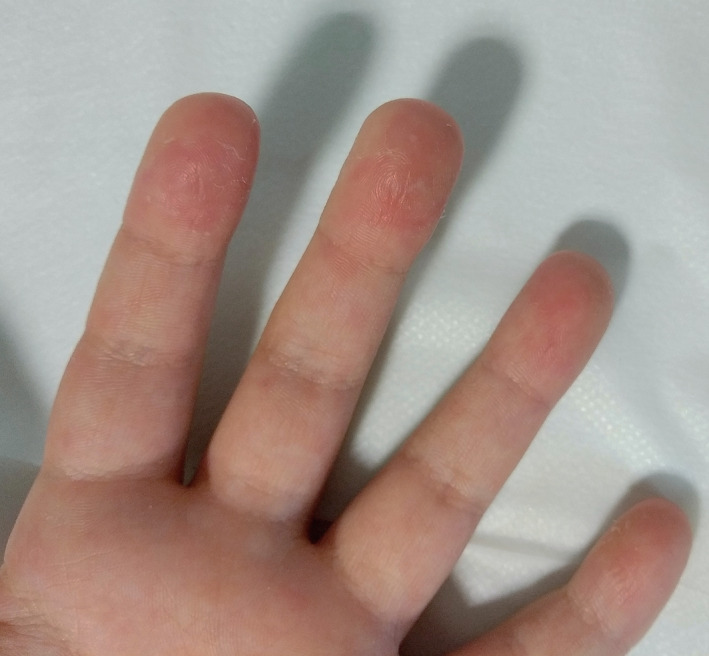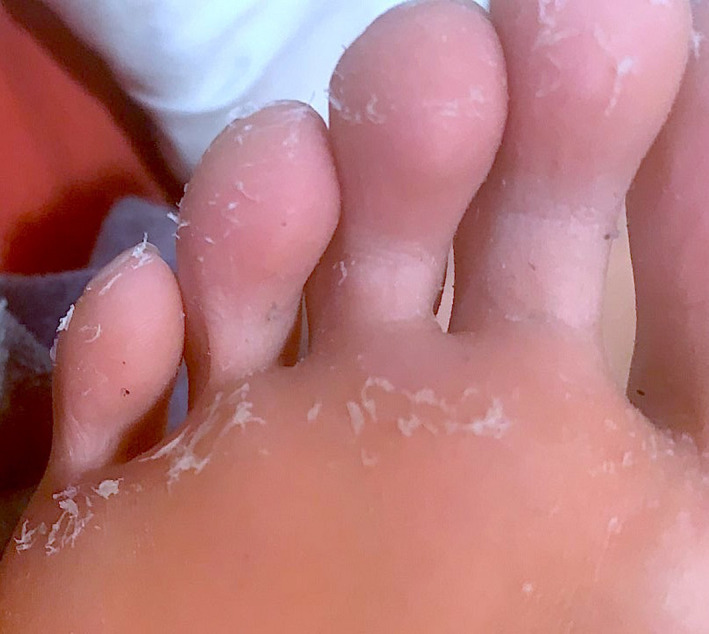Abstract
Skin lesions in children with proven COVID‐19 are not frequent in the literature apart from those associated with multisystem inflammatory syndrome. Fortunately, microbiologic testing for SARS‐CoV‐2 has become widely available not only for admitted patients but also for mild cases. We present a series of 6 children with mild erythema and desquamation of the fingertips and/or toes as the only skin manifestation of COVID‐19. As all children had asymptomatic to mildly symptomatic disease, it is reasonable to consider this a sign of benign disease and favorable outcome.
Keywords: COVID‐19, pediatric dermatology, pulpitis, SARS‐CoV‐2, skin
1. INTRODUCTION
Skin manifestations in patients with COVID‐19 have been extensively reported, mostly in adults. 1 , 2 Skin lesions in children with proven COVID‐19 are much less frequent 3 and may show specific features not seen in adults, such as those associated with the multisystem inflammatory syndrome in children (MIS‐C). 4
Once the microbiologic test for SARS‐CoV‐2 became widely available for all suspected cases in our institution (not only for admitted patients), we were able to diagnose the first case of acral pulpitis as an isolated sign of COVID‐19 in children. 5 Due to the mild nature of this presentation, in December 2020, we recruited similar cases through an advertisement on the “Spanish Primary Care Pediatric Association” website.
We present a series of six children infected with SARS‐CoV‐2 who presented with mild erythema and desquamation of the fingertips and/or toes as the only skin manifestation of COVID‐19. Otherwise, all children had asymptomatic to mildly symptomatic disease.
2. CASE REPORTS
Data were collected anonymously. We recorded age, sex, personal history of previous diseases, previous treatments, epidemiologic background, skin symptoms, type and location of lesions, systemic symptoms, microbiological test performed, and therapies administered.
Approval from the institutional Ethics Committee and Board was obtained. Informed consent was obtained for recording images in all patients.
Six patients (four male and two female), age range 5‐13 years, were included. Five had a positive microbiologic test for SARS‐CoV‐2 (three positive real‐time polymerase chain reaction for SARS‐CoV‐2 and two positive rapid antigenic test). One patient had a negative microbiologic test but was included due to a high clinical suspicious of COVID‐19 because of systemic symptoms (fever, cough, anosmia, and dysgeusia) and positive epidemiological context (close household contact with a positive confirmed case). Two of the six patients were completely asymptomatic and had been tested because of close contact with infected patients in one case and because of acral peeling in the other case.
Clinical characteristics of the cases are summarized in Table 1. None of the children had any prior acral scaling or desquamation; only one patient had history of atopic dermatitis. In patients with systemic symptoms, skin manifestations occurred 3 to 21 days after systemic symptoms. The skin lesions involved the fingers only in four cases, the toes only in one case, and both fingers and toes in one case. Mild erythema was followed by superficial desquamation. The lesions affected all fingers and/or toes in all patients (Figures 1,2). On the fingers, the eruption only involved the fingertips, sparing the rest of the palm. There was no involvement of the dorsal distal phalanges or the nail apparatus. The lesions only caused mild pruritus in one patient and local pain and pruritus in another one. The skin signs lasted 7 to 28 days and eventually disappeared without sequelae. No medical treatment was applied on the skin, aside from two patients who were treated with topical corticosteroids.
TABLE 1.
Characteristics of patients included
| Case | 1 | 2 | 3 | 4 | 5 | 6 |
|---|---|---|---|---|---|---|
| Gender | Female | Male | Male | Female | Male | Male |
| Age (y) | 9 | 12 | 10 | 5 | 9 | 13 |
| Previous conditions | None | Allergic rhinitis | None | Atopic dermatitis | None | Asthma |
| Previous treatment | None | None | None | None | None | None |
| Close contact with confirmed cases | No | Yes (parents) | Yes (parents) | Yes (parents) | No | Yes (brothers) |
| Systemic symptoms | Headache | Fever, cough, diarrhea | Fever, cough, anosmia, dysgeusia | None | None | Headache, myalgia |
| Duration of systemic symptoms | 3 d | 5 d | 9 d | None | None | 14 d |
| Site of involvement | Hands | Hands and feet | Hands | Hands | Hands | Feet |
| Cutaneous symptoms | Local pain and pruritus | None | None | Local pruritus | None | None |
| Duration of cutaneous symptoms | 28 d | 7 d | 14 d | 14 d | 21 d | 7 d |
| Treatments | None | Antipyretics | Antipyretics | Antihistamines, topical corticosteroids | Topical corticosteroids | None |
FIGURE 1.

Mild erythema and superficial desquamation of the fingertips
FIGURE 2.

Peeling of the toes
Due to the mild symptomatology of the patients, laboratory analyses and skin biopsies were not obtained.
3. DISCUSSION
We describe six children infected with SARS‐CoV‐2 who presented with an acral, erythematous, peeling condition as the only skin manifestation of COVID‐19. All cases had a favorable outcome in their infection, and their skin lesions disappeared, mostly spontaneously, in 1 to 4 weeks. Treatment was usually not necessary.
This skin condition has been very rarely reported during the COVID‐19 pandemic, and it is likely to have been overlooked. A reason for this may be that patients are asymptomatic or slightly symptomatic, and parents did not request medical attention. To our knowledge, only one case of desquamation of the distal phalanges of the hands and feet has been described in a 6‐year‐old girl with positive PCR for SARS‐CoV‐2 and generalized, giant urticaria. 6
Erythema and edema of the hands and feet followed by intense and diffuse scaling mimicking keratolysis exfoliativa has been related to COVID‐19 in children. 7 However, PCR has been negative in such cases. Edema of the hands and feet is also a manifestation of MIS‐C that can be later followed by acral desquamation. 4 , 8 However, our patients did not have systemic signs of MIS‐C and the acral peeling occurred without preceding edema and earlier than MIS‐C, which is usually a late‐onset complication of COVID‐19. 9
While the temporal relationship between acral peeling and COVID‐19 appears well established, we cannot exclude that this cutaneous sign might be related to other conditions. Only one of our cases had a history of atopic dermatitis, and none had suffered acral peeling before COVID‐19. In other conditions epidemiologically related to COVID‐19, such as COVID toes, negativity for microbiological tests has been claimed as the main argument against a causal link. 10 In the patients in our series, the demonstration of SARS‐CoV‐2 infection by PCR or rapid antigen test provides a strong support for a causal relation.
In the context of the COVID‐19 pandemic, appearance of acral erythema and desquamation in a child should raise the possibility of SARS‐CoV‐2 infection; PCR testing must be obtained, and, if positive, close contacts should be quarantined. The suspicion is stronger if the patient presents other typical COVID‐19 signs. The acral desquamation in COVID‐19 presented here is not associated with severe disease, and it is reasonable to consider this to be a sign of benign disease and favorable outcome. However, attention must be paid to other systemic signs of early MIS‐C, and the patients should be considered potentially infectious.
ETHICAL APPROVAL
From the institutional Ethics Committee and Board was obtained. Standard informed consents were obtained for recording images.
ACKNOWLEDGMENTS
To the “Spanish Primary Care Pediatric Association”.
Andina‐Martínez D, Villaizán‐Perez C, Pavo‐García MR, et al. Acral peeling as the sole skin manifestation of COVID‐19 in children. Pediatr Dermatol. 2021;38:664–666. 10.1111/pde.14599
REFERENCES
- 1. Galván Casas C, Català A, Carretero Hernández G, et al. Classification of the cutaneous manifestations of COVID‐19: a rapid prospective nationwide consensus study in Spain with 375 cases. Br J Dermatol. 2020;183(1):71‐77. [DOI] [PMC free article] [PubMed] [Google Scholar]
- 2. Marzano AV, Cassano N, Genovese G, et al. Cutaneous manifestations in patients with COVID‐19: a preliminary review of an emerging issue. Br J Dermatol. 2020;183(3):431‐442. [DOI] [PMC free article] [PubMed] [Google Scholar]
- 3. Andina D, Belloni‐Fortina A, Bodemer C, et al. Skin manifestations of COVID‐19 in children: part 2. Clin Exp Dermatol. 2021;46(3):451‐461. 10.1111/ced.14482 [DOI] [PMC free article] [PubMed] [Google Scholar]
- 4. Young TK, Shaw KS, Shah JK, et al. Mucocutaneous manifestations of multisystem inflammatory syndrome in children during the COVID‐19 pandemic. JAMA Dermatol. 2021;157(2):207‐212. [DOI] [PMC free article] [PubMed] [Google Scholar]
- 5. Andina Martínez D, Vinagre Enríquez S, Molina Cabañero JC. Palmar pulpitis as an isolated expression of SARS‐CoV‐2 infection. Aten Primaria. 2020;53(2):101955. [DOI] [PMC free article] [PubMed] [Google Scholar]
- 6. Rotulo GA, Signa S, Rosina S, et al. Giant Urticaria and Acral peeling in a child with coronavirus disease 2019. J Pediatr. 2020;230:261‐263. [DOI] [PMC free article] [PubMed] [Google Scholar]
- 7. Neri I, Patrizi A, Gabrielli L, et al. Acral skin eruption observed during SARS‐CoV‐2 pandemic: possible keratolysis exfoliativa with red palms and soles. J Eur Acad Dermatol Venereol. 2020;34(12):e783‐e785. [DOI] [PMC free article] [PubMed] [Google Scholar]
- 8. Rekhtman S, Tannenbaum R, Strunk A, et al. Mucocutaneous disease and related clinical characteristics in hospitalized children and adolescents with COVID‐19 and multisystem inflammatory syndrome in children. J Am Acad Dermatol. 2021;84(2):408‐414. [DOI] [PMC free article] [PubMed] [Google Scholar]
- 9. Belot A, Antona D, Renolleau S, et al. SARS‐CoV‐2‐related paediatric inflammatory multisystem syndrome, an epidemiological study, France, 1 March to 17 May 2020. Euro Surveill. 2020;25(22):2001010. [DOI] [PMC free article] [PubMed] [Google Scholar]
- 10. Baeck M, Herman A. COVID toes: where do we stand with the current evidence?. Int J Infect Dis. 2021;102:53‐55. [DOI] [PMC free article] [PubMed] [Google Scholar]


